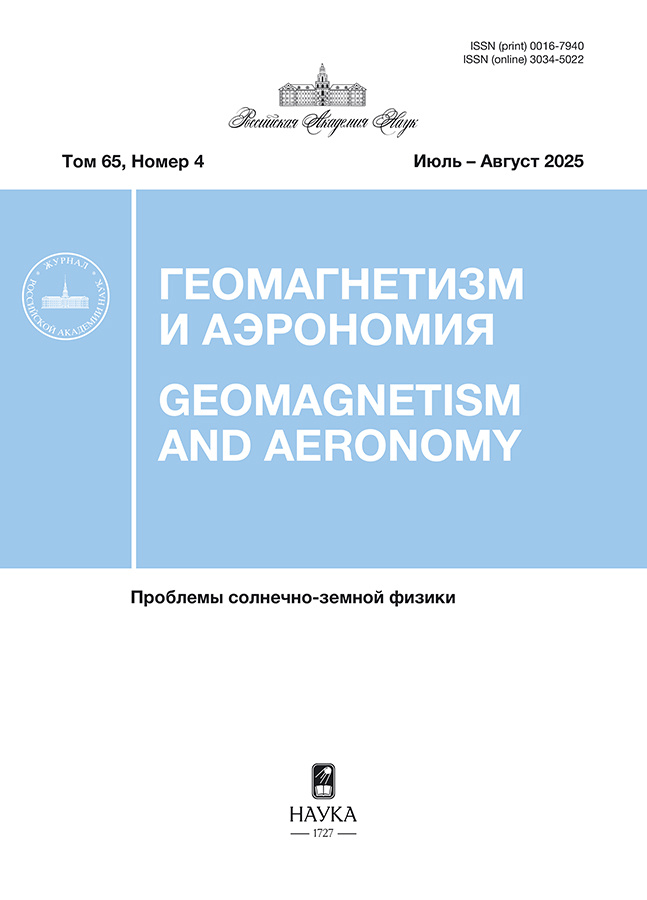Magnetic flux ropes as models of a solar flare and transition of flare filament into CMI-regim of motion
- 作者: Solov’ev A.A.1, Korolkova О.А.1, Kirichek Е.А.1
-
隶属关系:
- Central Astronomical Observatory of the Russian Academy of Sciences at Pulkovo
- 期: 卷 65, 编号 4 (2025)
- 页面: 421-429
- 栏目: Articles
- URL: https://ruspoj.com/0016-7940/article/view/688272
- DOI: https://doi.org/10.31857/S0016794025040018
- EDN: https://elibrary.ru/EXCAIG
- ID: 688272
如何引用文章
详细
A new physical mechanism of flare energy release in force-free magnetic flux ropes is described: as the top of the magnetic rope-loop enters the corona, the external pressure G, which keeps it from expanding, steadily decreases. At its critically low value, the longitudinal field tends to zero on the magnetic surface where the currents change sign, and the force-free parameter and azimuthal current near this surface grow without limit, approaching the rupture. This excites plasma turbulence in the rope and serves as a flare trigger. Rapid dissipation of the field and currents on the anomalous plasma resistance induces an electric field much higher than the Dreiser field. The forces acting on the flare filament in the corona are described, and the conditions for its transition to the dynamic CME regime are discussed.
全文:
作者简介
A. Solov’ev
Central Astronomical Observatory of the Russian Academy of Sciences at Pulkovo
编辑信件的主要联系方式.
Email: solov@gaoran.ru
俄罗斯联邦, St. Petersburg
О. Korolkova
Central Astronomical Observatory of the Russian Academy of Sciences at Pulkovo
Email: korolkova@gaoran.ru
俄罗斯联邦, St. Petersburg
Е. Kirichek
Central Astronomical Observatory of the Russian Academy of Sciences at Pulkovo
Email: elenakirichek@gmail.com
俄罗斯联邦, St. Petersburg
参考
- Арцимович Л.А., Сагдеев Р.3. Физика плазмы для физиков. М.: Атомиздат, 278 c. 1979.
- Бакунина И.А., Мельников В.Ф., Шаин А.В., Кузнецов С.А., Абрамов-Максимов В.Е. Поведение микроволнового излучения в активных областях c “запертыми” и “открытыми” магнитными жгутами / Труды 28-й Всероссийской конференции “Солнечная и солнечно-земная физика”. СПб. ГАО РАН. 7‒11 октября 2024. С. 25‒28. https://doi.org/10.31725/0552-5829-2024-25-28
- Кадомцев В.В. Перезамыкание силовых линий в магнитной гидродинамике // “Нелинейные волны” под ред. Гапонова-Грехова А.В., М.: Наука. С. 131‒163. 1979.
- Каплан С.А., Цытович В.Н. Плазменная астрофизика. Серия: Проблемы теоретической астрофизики. М.: Наука, 440 с. 1972.
- Ландау Л.Д., Лифшиц Е.М. Теоретическая физика. Т. 8. Электродинамика сплошных сред. М.: Наука, 621 с. 1982.
- Bakunina I.A., Melnikov V.F., Shain A.V., Kuznetsov S.A., Abramov-Maximov V.E. Spatial Position of Magnetic Flux Ropes in Flare Active Regions with and without Coronal Mass Ejections // Geomagnetism and Aeronomy. V. 64. № 8. Р. 1237–1249. 2024. https://doi.org/10.1134/S0016793224700336
- Chen B., Shen C., Gary D. et al. Microwave Spectral Imaging of an Erupting Magnetic Flux Rope During a Large Solar Flare // Nature Astronomy. V. 4. P. 1140‒1147. 2020. https://doi.org/10.1038/s41550-020-1147-7
- Fleishman G.D., Gary D.E., Chen B., Kurod N., Yu S., Nita G.M. Decay of the coronal magnetic field can release sufficient energy to power a solar flare // Science. V. 367. P. 278‒280. 2020. https://doi.org/10.1126/science.aax6874
- Fleishman G.D., Nita G.M., Chen B., Yu S. and Gary D.E. Solar flare accelerates nearly all electrons in a large coronal volume // Nature. V. 606. P. 674‒677. 2022. https://doi.org/10.1038/s41586-022-04728-8
- Ji H., Wang H., Schmahl E.J., Moon Y.J., Jiang Y. Observations of the failed eruptions of the filament // Ap. J. V. 595. P. L135‒L138. 2003. https://doi.org/10.1086/378178
- Melnikov V.F., Meshalkina N.S. Contraction Effect of Coronal Loops during the Flare of February 24, 2023 // Geomagnetism and Aeronomy. V. 64. № 8. P. 1381–1385. 2024. https://doi.org/10.1134/S001679322470052X
- Parker E.N. Cosmical Magnetic Fields. Part 1. Oxford: Clarendon Press, 858 p. 1979.
- Priest E. Solar Magnetohydrodynamics. Reidel Publishing Company, 469 p. 1982.
- Priest E., Forbes T. Magnetic reconnection. MHD theory and applications. Cambridge, UK: Cambridge university press. 2000. https://doi.org/10.1017/CBO9780511525087
- Solov’ev A.A., Kirichek E.A. Force free magnetic flux ropes: inner structure and basic properties // MNRAS. V. 505. P. 4406‒4416. 2021. https://doi.org/10.1093/mnras/stab1565
- Solov’ev A.A. Force free magnetic flux ropes: string confinement of super-strong magnetic fields and flare energy release // MNRAS. V. 515. P. 4981‒4989. 2022. https://doi.org/10.1093/mnras/stac1818
- Solov’ev A.A., Kirichek E.A. Properties of flare energy release in force free magnetic flux ropes // Astronomy Letters. V. 49. № 5. P. 257‒269. 2023. https://doi.org/10.1134/S1063773723050055
- Solov’ev A.A., Korolkova O.A., Kirichek E.A. Magnetic flux ropes on the Sun: electric currents and flare activity // Geomagnetism and Aeronomy. V. 63. № 8. P. 1120‒1135. 2023. https://doi.org/10.1134/S0016793223080200
- Solov’ev A.A. Force Free Magnetic Flux Rope with a High Current Density on the Axis // Astronomy Reports. V. 101. № 6. P. 601‒609. 2024. https://doi.org/10.1134/S1063772924700550
- Solov’ev A.A., Murawski K. Does the region of flare-energy release work as a vacuum-cleaner? // Astrophys. аnd Space Sci. 2014. V. 350. P. 11–19. 2014. https://doi.org/10.1007/S10509-013-1716-7
- Wang H., Cao W., Liu Ch., Xu Y., Liu R., Zeng Zh., Chae J., Ji H. Witnessing magnetic twist with high-resolution observation from the 1.6-m New Solar Telescope // Nature Communications. V. 6: 7008. 2015. https://doi.org/10.1038/ncomms8008
补充文件
















